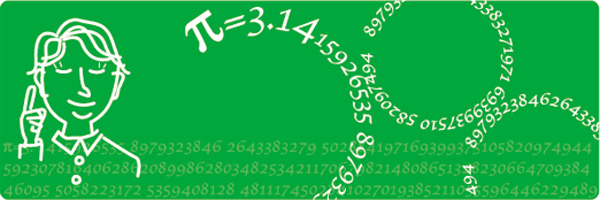- トップページ
- Fantastic Voyagers
- The art of memory – How to utilize 100% of your brain capacity

In medieval Europe, “memorization” was considered an extremely important skill.
But just how do you go about memorizing huge quantities of information?
Pi. We all know how it begins: 3.14… and then an infinite series of decimals. But did you know that there are actually people who passionately try to memorize the digits of Pi? The current world record holder is a Japanese man named Akira Haraguchi, who recited a stunning 100,000 decimals in 2006. (His own previous record was 83,431.) The obvious question is, of course, how can he possibly do it? The trick seems to involve a kind of word game. Haraguchi uses an original system where he lets the digits correspond to syllables, and then makes up a “majestic story” based on those syllables, all the way to the world record length.
Back in a different age in medieval Europe, books were extremely rare and valuable items and were kept under strict supervision in monasteries and private libraries. Consequently, it was of utmost importance for scholars to memorize the contents of those volumes. For this purpose, various forms of “mnemonics” were developed. The tradition of the “art of memory” went all the way back to ancient Greece, where the orators of the day where able to deliver long speeches entirely from memory.
In the most common form of mnemonics used in ancient Greece and Rome, the information to be memorized was associated with a space. First you would create in your mind the image of a wax tablet or a papyrus scroll (i.e. something to write on). Then you would line up the things to memorize, as if writing them down. In this way, when you later needed to recall the information, all you had to do was bring up the wax tablet or papyrus scroll in your mind’s eye and call forth the things in order. The trick to make this work was to insert inspiring markers along the way, such as a golden hand or the name of a friend. This was the basic idea, and then association methods and rhyming games were added to strengthen the memories.
Another popular method was to use the image of a storage space. While a wax tablet is only two-dimensional, using a storage space enables memorizing in three dimensions. It could be a dovecote, an animal pen, or maybe a beehive. Today, a bookshelf or a library comes readily to mind.
These mnemonics, constructed upon an underlying theory of space and an individual set of rules, were unmistakably a kind of technological system. They were fundamentally different from the way today’s students cram their heads full of mathematical formulas and historical dates by brute force on the night before an exam.
These days, memorizing things is not considered so important any more. Your friends’ phone numbers are stored in your mobile phone, and an overwhelming wealth of information is just a few clicks away over the Internet. Committing large quantities of information to memory has been relegated to a “hobby,” such as memorizing the decimals of Pi. Some people even say it’s “better to use one’s head for something creative, rather than just stuffing it with information.”
But in the Middle Ages, things were different. They had no computers, of course, and very few people had access to books. Keeping huge quantities of data in your head was a prerequisite for any form of creative thought. On the other hand, what you had in your head was always accessible and that was no doubt how many epoch-making ideas were born.
A bookshelf full of books is meaningless if you never get round to reading those books. Now that we no longer need to force ourselves to memorize things, perhaps the time has come to reconsider the importance of memorization.
